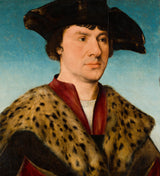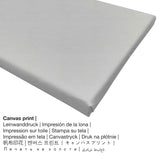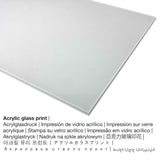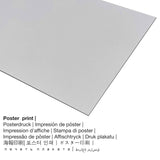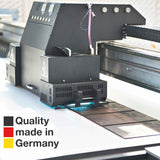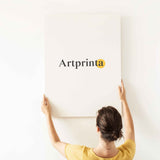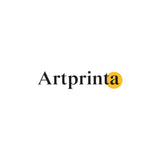Joos van Cleve, 1530 - Eserese nke nwoke - mbipụta nka mara mma
Ụtụ gụnyere. Mbupu gbakọrọ na ndenye ọpụpụ.
Nkọwa nka mbụ sitere na webụsaịtị Mauritshuis (© - Maurithuis - www.mauritshuis.nl)
Presumably English Royal Collection, 1688, as by Hans Holbein the Younger, and subsequently in the collection of the Dutch Stadholders in or before 1712 (see The Hague 1988-1989, no. V); Nationale Konst-Gallery, The Hague, 1801-1808; Rijksmuseum, Amsterdam (inv. no. SK-A-165), kemgbe 1885; na ogologo oge mbinye si Rijksmuseum, kemgbe 1951
Kedu ụdị ngwaahịa anyị na-enye gị?
Eserese nke nwoke was created by Joos van Cleve in 1530. Ihe gafere 490 Emere ụdị izizi dị otu afọ na oke zuru oke: elu: 45,7 cm obosara: 43,4 cm | elu: 18 n'obosara: 17,1 inch e weputara ya na ihe ndi ozo mmanụ na panel. Taa, ihe osise nwere ike na-elele na na Ndị Maurithuis nchịkọta dijitalụ dị na Hague, South Holland, Netherlands. a nka ochie ngalaba ọha artpiece is being provided with courtesy of Mauritshuis, The Hague. Moreover, the work of art has the creditline: Presumably English Royal Collection, 1688, as by Hans Holbein the Younger, and subsequently in the collection of the Dutch Stadholders in or before 1712 (see The Hague 1988-1989, no. V); Nationale Konst-Gallery, The Hague, 1801-1808; Rijksmuseum, Amsterdam (inv. no. SK-A-165), kemgbe 1885; na ogologo oge mbinye si Rijksmuseum, since 1951. In addition to this, the alignment of the digital reproduction is in portrait format ma nwee oke nke 1: 1.2, meaning that the length is 20% shorter than the width. The Netherlandish painter Joos van Cleve was a European artist from the Netherlands, whose style was mainly Northern Renaissance. The Northern Renaissance painter was born in the year 1485 na Cleves, North Rhine-Westphalia, Germany ma nwụọ mgbe ọ dị afọ 56 n'afọ 1541 na Antwerp, Antwerpen Province, Flanders, Belgium.
Nye iwu ihe ị chọrọ
Anyị na-enye ụdị nha na ihe dị iche iche maka ngwaahịa ọ bụla. Họrọ n'ime nhọrọ ngwaahịa ndị a ugbu a ka ị kwekọọ na mmasị gị na nha na akụrụngwa:
- Mbipụta kanvas: The printed canvas material mounted on a wooden frame. Your printed canvas of this artwork will give you the unique opportunity to transform your new art print into a large artwork as you know from art galleries. Hanging your canvas print: The advantage of canvas prints is that they are relatively low in weight, which implies that it is easy to hang up the Canvas print without the use of any wall-mounts. Hence, a canvas print is suitable for all kinds of walls.
- Mpempe akwụkwọ mmado ebipụtara na akwa akwa: Our poster print is a UV printed sheet of canvas paper with a fine surface texture. It is suited for placing your art print in a custom-made frame. Please keep in mind, that depending on the absolute size of the canvas poster print we add a white margin of something between 2-6cm around the work of art, which facilitates the framing.
- Mbipụta iko acrylic (nke nwere ezigbo mkpuchi iko): The acrylic glass print, often referred to as a print on plexiglass, will convert the original into magnificient décor. Further, the acrylic fine art print forms a good alternative option to aluminium and canvas fine art replicas. The work of art will be custom-made with the help of modern UV direct printing technology. The major advantage of an acrylic glass print is that contrasts and small image details will be visible because of the subtle gradation. The plexiglass protects your custom fine art print against light and external influences for many more years.
- Mbipụta nke aluminom: Aluminium Dibond prints are metal prints with an outstanding depth effect. The non-reflective surface structure make a contemporary look. The bright & white parts of the original work of art shine with a silky gloss but without any glow. The colors of the print are luminous, fine details of the print appear very clear. This UV print on aluminium is one of the most popular entry-level products and is a stylish way to showcase fine art reproductions, because it draws attention on the whole artwork.
Ihe omuma ihe nka
| Ihe nkiri: | Joos van Cleve |
| A makwaara dịka: | Joos van Cleve, Joos van Cleve d.Ä., Master of the Death of the Virgin, Beke Joos van der, Joos van Cleve alias Sotte Cleef, Cleve, Sottecleef, Zotte Kleef, Cleef Joos van, Cleve Joos van, Sotte Cleeff, joos van cleve d. a., Cleve Joos van the elder, de Zotte Kleef, Sotte Cleef, Cleve Joos van der Beke, de Sotte van Kleeff, Sotte Kleef, Cleef Joos van der Beke, de Sotte Cleef, Joos van Cleef, Kleef Joos van, de Sotte Kleef, Meister des Todes Mariae, Cleve Joos van der Beke van, Josse van Cleve, Cleve Joos van d.Ä., Cleve Joos van D. A., Sottecleet, J. Van Cléef, Van Cleve Joos, joost van cleve, Zotte van Kleef |
| okike onye nka: | nwoke |
| Nationality: | Dutch |
| Ọrụ onye na-ese ihe: | Onye na-ese ihe na Netherlands |
| Mba onye si: | mba netherland |
| Nhazi nke onye nka: | nna ukwu ochie |
| styles: | Northern Renaissance |
| Ndụ: | 56 afọ |
| Amụrụ n'afọ: | 1485 |
| Obodo: | Cleves, North Rhine-Westphalia, Germany |
| Afọ ọnwụ: | 1541 |
| Ebe ọnwụ: | Antwerp, Antwerpen n'ógbè, Flanders, Belgium |
Nkọwa ihe osise
| Aha eserese: | "Ihe osise nke nwoke" |
| Nhazi nka: | sere |
| Okwu mkpokọta: | nka ochie |
| oge: | 16th narị afọ |
| Emepụtara na: | 1530 |
| Afọ nka: | ihe dị ka afọ 490 |
| Ihe osise izizi: | mmanụ na panel |
| Nha izizi nka: | elu: 45,7 cm obosara: 43,4 cm |
| Ụlọ ihe ngosi nka / ebe: | Maurithuis |
| Ebe ngosi nka: | Hague, South Holland, Netherlands |
| URL webụ: | Maurithuis |
| Ụdị nka nka: | ngalaba ọha |
| Site n'aka: | Maurithuis, Hague |
| Ebe E Si Nweta: | Presumably English Royal Collection, 1688, as by Hans Holbein the Younger, and subsequently in the collection of the Dutch Stadholders in or before 1712 (see The Hague 1988-1989, no. V); Nationale Konst-Gallery, The Hague, 1801-1808; Rijksmuseum, Amsterdam (inv. no. SK-A-165), kemgbe 1885; na ogologo oge mbinye si Rijksmuseum, kemgbe 1951 |
Product ọmụma
| Nkewa ngwaahịa: | mmepụta nka |
| Usoro mmeputakwa: | dijitalụ mmeputakwa |
| Produzọ mmepụta: | Mbipụta UV ozugbo (mbipụta dijitalụ) |
| Nlụpụta: | German mere |
| Stockdị ngwaahịa: | a na-achọ |
| Eji ngwaahịa a chọrọ: | ụlọ mmepụta ihe nka, nka mgbidi |
| Nhazi: | nhazi ihe osise |
| Njikwa oyiyi: | ogologo ruo obosara 1: 1.2 |
| Mmetụta akụkụ onyonyo: | ogologo bụ 20% mkpụmkpụ karịa obosara |
| Akụrụngwa ị nwere ike ịhọrọ: | akwụkwọ mmado (akwụkwọ kwaaji), mbipụta enyo acrylic (nke nwere ezigbo mkpuchi iko), mbipụta ọla (aluminium dibond), mbipụta kwaaji |
| Mpempe akwa akwa (akwa akwa na etiti ihe ndọtị) nha: | 50x60cm - 20x24", 100x120cm - 39x47", 150x180cm - 59x71" |
| Mpempe iko acrylic (nwere ezigbo mkpuchi iko) nha dị iche iche: | 50x60cm - 20x24", 100x120cm - 39x47", 150x180cm - 59x71" |
| Mbipụta akwụkwọ mmado (akwụkwọ kwaaji): | 50x60cm - 20x24", 100x120cm - 39x47" |
| Nhọrọ ebipụta aluminom: | 50x60cm - 20x24", 100x120cm - 39x47" |
| Igwe onyonyo: | mmeputakwa na-enweghị isi |
Nkwupụta iwu: We try the best we can in order to describe our products in as much detail as possible and to illustrate them visually on the product detail pages. Although, the colors of the print products and the print result may diverge somehwat from the image on your device's monitor. Depending on your screen settings and the condition of the surface, not all colors can be printed one hundret percent realistically. Bearing in mind that our art reproductions are processed and printed by hand, there might as well be slight deviations in the motif's exact position and the size.
© Nchekwa ikike nwebisiinka, Artprinta (www.artprinta.com)

